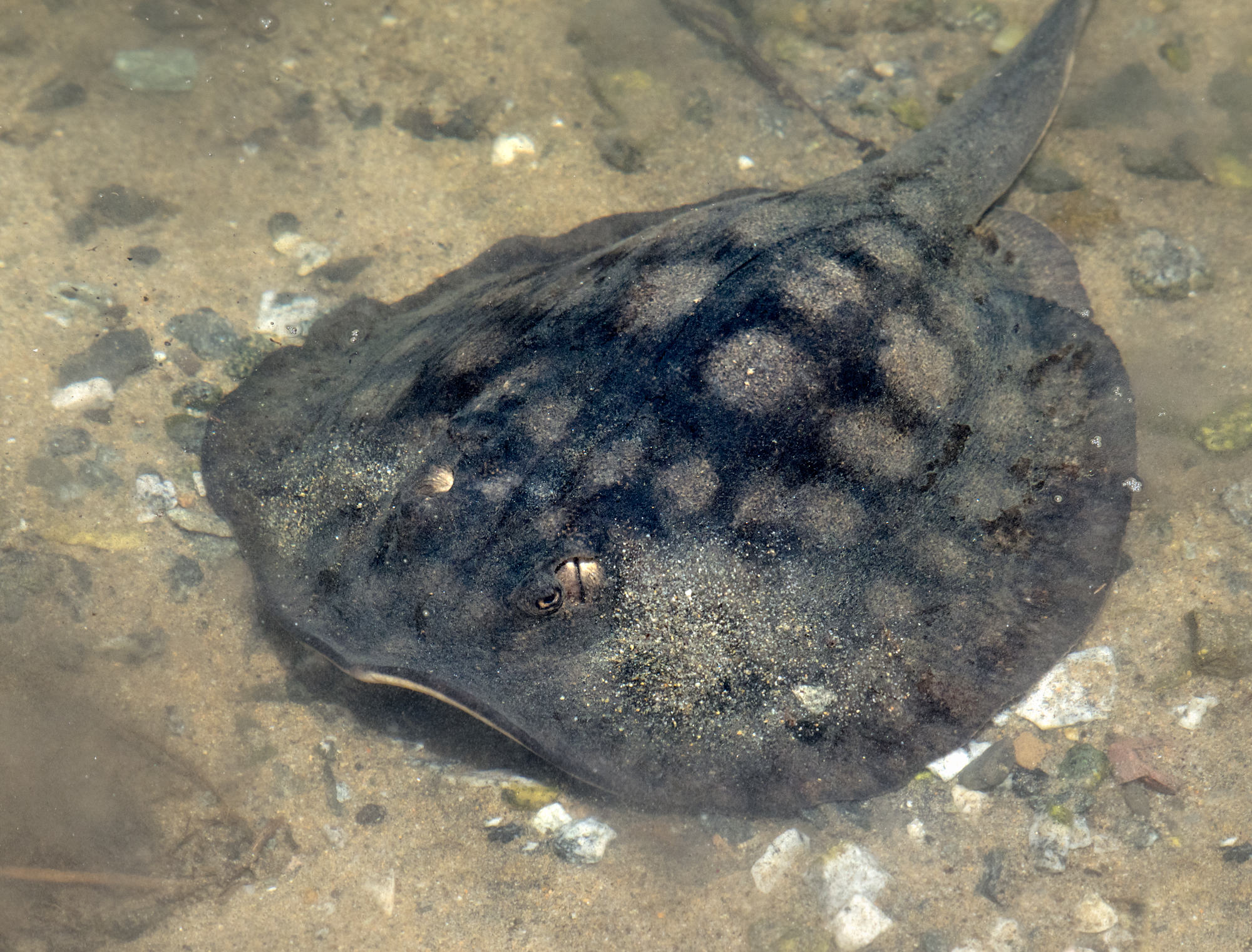Although she cannot read, Charlotte the round stingray recently found herself at the center of a tabloid scandal with biblical undertones. In September, at the Aquarium & Shark Lab in Hendersonville, N.C., Charlotte's pancake-shaped body began to swell. Her keepers, worried she had a tumor, gave the stingray an ultrasound to check for cancerous lumps or growths. But the ultrasound revealed Charlotte's strange lumps were actually eggs. Charlotte was pregnant, despite living in a tank with no other stingrays. In fact, she hadn't been housed with a male stingray of her species in eight years. But her tank did have two newcomers: a pair of male whitespotted bamboo sharks named Larry and Moe who joined Charlotte last summer. The aquarium workers also noticed the stingray had bite marks, which often accompany mating in sharks.
In a live Facebook stream of one of Charlotte's ultrasounds, Brenda Ramer, the founder and executive director of the aquarium, explained there were two possible explanations for Charlotte's conception. The first, Ramer explained, was parthogenesis, a phenomenon in which species can reproduce without any involvement of the opposite sex. The other? "There's the potential she mated with one of these young male sharks," Ramer said. The headlines ran amok: "'Miraculous birth' expected from stingray with no mate, possibly impregnated by shark," declared WRALNews. "Pregnant Stingray Could Have Been Impregnated by Shark: 'A Science Mystery,'" asserted People. "RAY OF SUNSHINE: Pregnant stingray could be having SHARK’S ‘hybrid’ babies as aquarium thinks it’s solved ‘miraculous’ mystery," titillated The Sun.
Although Charlotte is undoubtedly a special fish—all fish are special—her pregnancy is not miraculous, and almost certainly unaffiliated with Larry, Moe, or any other shark. Her pregnancy is most likely the product of parthenogenesis, which is usually the answer to any viral story whenever a female animal in captivity winds up pregnant with no other mate. "I saw the headline, and I'm like no way," said Noah Bressman, a fish physiologist at Salisbury University in Maryland. "I'm like, it must have been parthenogenesis."
It's true that hybrids sometimes pop up when animals of different species are kept together in captivity. In 1985, a female bottlenose dolphin and male false killer whale housed in the same tank at a marine park in Hawaii produced a wholphin. In 2020, a lab accidentally combined sperm from an American paddlefish and eggs from a Russian sturgeon to create hundreds of "sturddlefish." And elsewhere, more intentional hybrids abound, such as zorses, mules, and ligers.
But a hybrid's existence is contingent on the genetic similarity of their two parents' species. If two species are too far apart genetically or have different numbers of chromosomes, the offspring may not live or may be sterile, if they were even able to mate in the first place. A bamboo shark and a round stingray are different sizes and would not have compatible anatomy, Kady Lyons, a research scientist at the Georgia Aquarium, who researched the stingrays in graduate school, told the AP. Bressman told me: "You get over, let's say, 300 million of years of evolution between sharks and rays, the more unlikely it is that the genetic information from these parents could ever possibly combine."
Parthenogenesis removes many of these complicating factors from the puzzle of pregnancy. It is not the same as self-fertilization, which happens when hermaphroditic animals combine their male and female parts. In parthenogenesis, the embryos develop from eggs that are never fertilized. This reproductive process is extremely common in invertebrates and thought to be rare in vertebrates. As far as evolutionary strategies go, it's a quick and easy way to reproduce but not a great long-term strategy, as it sacrifices the genetic diversity that accompanies mating. But scientists have been discovering more and more female vertebrates that can reproduce without any sperm, according to a story in Science. Parthenogenesis has been documented in California condors, New Mexico whiptail lizards, Komodo dragons, boa constrictors, and American crocodiles.
Several species of sharks are also on this list, according to a story in BioScience. In 2001, an aquarium in Nebraska found a tank holding three female bonnethead sharks had welcomed a bonnethead pup. The three females had been collected from the Florida Keys well before sexual maturity, and the only males in the tank were other species: wobbegongs and bamboo sharks (always at the center of the drama!). Genetic testing proved the pup was the result of parthenogenesis. In 2007, the Virginia Aquarium discovered a 9-year-old female blacktip shark named Tidbit was pregnant with a parthenogenetic pup. In 2022, the Shedd Aquarium in Chicago announced their zebra shark, Bubbles, had given birth to two parthenogenetic pups.
"Captivity really makes parthenogenesis more obvious," Bressman said. "It's likely that it happens in the wild, too, but we're unlikely to see it." It would be logistically impossible for scientists to sample parents and their offspring in the wild to see which rays may or may not have fathered unruly pups.
Charlotte's case would make her the first documented example of parthenogenesis in her species. "It's never been described in a ray before," Bressman said. "But that's because it's likely a rare situation." It's also possible that Charlotte could have stored sperm from a long-ago rendezvous. Scientists don't know if round stingrays can store sperm, but Lyons noted some species of shark can store sperm for long periods of time, even for nearly four years, in a paper titled "Who's My Daddy? Considerations for the influence of sexual selection on multiple paternity in elasmobranch mating systems."
When I first encountered the story of Charlotte the stingray, I assumed the Aquarium & Shark Lab had thrown out the possibility of a shark father as a joke to get reporters to bite on this story of an unmated pregnancy. It clearly worked—how many stingrays get covered in People, a magazine named for the specific kind of animal it covers? But as the coverage spread, it seemed clear that many people encountering this story truly believed that sharks and rays could mate and produce hybrid young, or, as the aquarium's founder Ramer has described in interviews, "some kind of a potential mixed breed."
After some digging, I no longer think Ramer was joking. "With all of the interest and chaos surrounding Charlotte, I am going to ask that you please do not use our platform for wonder and research to make a personal stand or comments to prove yourself and your knowledge to other readers," Ramer wrote in a Facebook post on the aquarium's page. "Charlotte is a special and lovely fish. We are sharing her experience with you as a way to learn together. It is our gift. Please, do not disqualify our event. Just because something has not happened or has not been documented does not make it impossible. Science is discovery. And besides, none of us know what has happened in the big ocean because we are not always there."
All will be revealed soon, as the Aquarium & Shark Lab predicts Charlotte could give birth in the next two weeks. And what have we learned from this? If you make even the slightest suggestion that a shark and ray had sex, many media outlets will run with that suggestion. If you're an aquarium, this is probably great for business. If you are the stingray at the center of a pregnancy scandal, you are probably doing fine because you have no concept of social media. Actually, you are probably doing way better than all of us. Only one thing is certain: None of us know what has happened in the big ocean because we are not always there.






